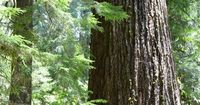In the thickly forested hills east of Coquille, Oregon, a towering giant—one of the world’s tallest Douglas firs—has become the center of a dramatic firefighting effort that has gripped both locals and tree enthusiasts far beyond the Pacific Northwest. The Doerner Fir, a behemoth standing at over 325 feet tall and estimated to be between 450 and 500 years old, caught fire on Saturday, August 16, 2025. Since then, firefighters and forestry officials have been working around the clock to save this iconic tree, which has stood as a living monument through centuries of storms, logging, and now, a rare and dangerous blaze.
The initial call about the fire came in at 2:30 p.m. on Bureau of Land Management (BLM) land in Coos County. According to the Coos Forest Protective Association—a nonprofit responsible for wildland fire protection in the region—crews responded rapidly, establishing a containment line and setting up sprinklers at the tree’s base to prevent the flames from spreading along the ground. Helicopter teams were soon deployed, dropping buckets of water on the burning canopy and managing to knock back the worst of the flames at the very top of the tree.
Yet, the battle was far from over. Deep inside the trunk, about 250 to 280 feet up, smoldering flames continued to burn. Brett Weidemiller, assistant unit forester with the Coos Forest Protective Association, explained to The Oregonian/OregonLive just how perilous the situation was for those on the ground: “You figure that a 50-foot chunk of tree falling 200 feet and hitting a firefighter, you can imagine what can happen as a result.” Indeed, the fire had already caused a 50-foot-long section of the tree to crash to the forest floor, underlining the tremendous risk posed by falling debris.
Because of this danger, fire managers made the difficult decision to rule out sending climbing crews into the tree. Instead, as Megan Harper, public affairs specialist for the BLM, told OPB, “firefighters are working to identify additional ways to reach and extinguish the fire.” Drones, helicopters, and sprinklers have become the tools of choice in this unusual firefighting operation. “It’s kind of an assessment game,” Weidemiller said, describing the ongoing process of figuring out the safest and most effective method to put the fire out at the top of the tree.
The Doerner Fir—historically known as the Brummit Fir before being renamed in honor of Ray Doerner, a former Douglas County commissioner and longtime BLM employee—has a diameter stretching nearly 12 feet. It’s one of the tallest non-redwood trees on the planet, a rare survivor of a once-vast forest of giants. Decades of intensive logging have left the Doerner Fir standing alone, a celebrated landmark and a living link to Oregon’s ancient forests.
As of Tuesday, August 19, firefighters were still in “observation mode,” watching closely to see if the helicopter drops had succeeded in cooling the persistent hot spot some 280 feet above the ground. “That’s the area of focus right now to see if we can get that spot cooled down because of the thick bark,” Harper explained to The Guardian. She noted that the tree’s impressive height, while awe-inspiring, also makes it especially vulnerable to lightning strikes and falling debris. Over the hot, dry summer, dried moss, bark, and pitch had accumulated on the tree—materials that Harper described as “all flammable.” She added, “It’s an older tree, it has a lot of pitch that’s coming out of it, that sticky, sugary substance that has the potential to be pretty flammable.”
While the fire has been contained to the single tree, the situation remains precarious. Crews have created a wide trail around the Doerner Fir to keep personnel safe from falling limbs and debris, and more than a dozen firefighters remain actively engaged in the effort. Two helicopters are stationed nearby, ready to respond if flames flare up again. The Doerner Fir Recreation Area has been closed to the public until further notice, with the Coos Forest Protective Association urging visitors to stay away due to ongoing firefighting operations and the risks posed by the unstable tree.
Fire investigators from the Bureau of Land Management are still working to determine what sparked the blaze. While the tree’s height makes it a likely target for lightning, no definitive cause has been established yet. “It’s actually pretty rare to have one of these big old trees catch fire like this,” Harper told OPB, reflecting the sense of shock and concern felt by many in the forestry community. Still, she remains cautiously optimistic about the tree’s fate: “Being a whole tree, the chances that the whole tree is going to burn is pretty small. I think that there will definitely be the Doerner Fir still there.”
The fire’s impact has already left its mark, with a significant portion of the tree lost and the future of the Doerner Fir still uncertain. Yet, the response from both local and federal agencies has been swift and coordinated, drawing on a range of expertise and equipment. Firefighters have leaned heavily on technology—drones for aerial assessment, helicopters for targeted water drops, and remote monitoring tools—to minimize risk to personnel while maximizing their chances of saving the tree.
This incident has also highlighted the vulnerability of Oregon’s remaining old-growth giants, many of which are increasingly isolated due to past logging. The Doerner Fir’s survival would be a testament to both nature’s resilience and human determination. For now, the firefighting teams remain vigilant, ready to adapt their tactics as conditions change, all in hopes of preserving a tree that has stood for nearly half a millennium.
As the investigation continues and the firefighting effort grinds on, the Doerner Fir stands battered but not yet beaten—a living relic of Oregon’s wild past, and, with any luck, a survivor for generations to come.


